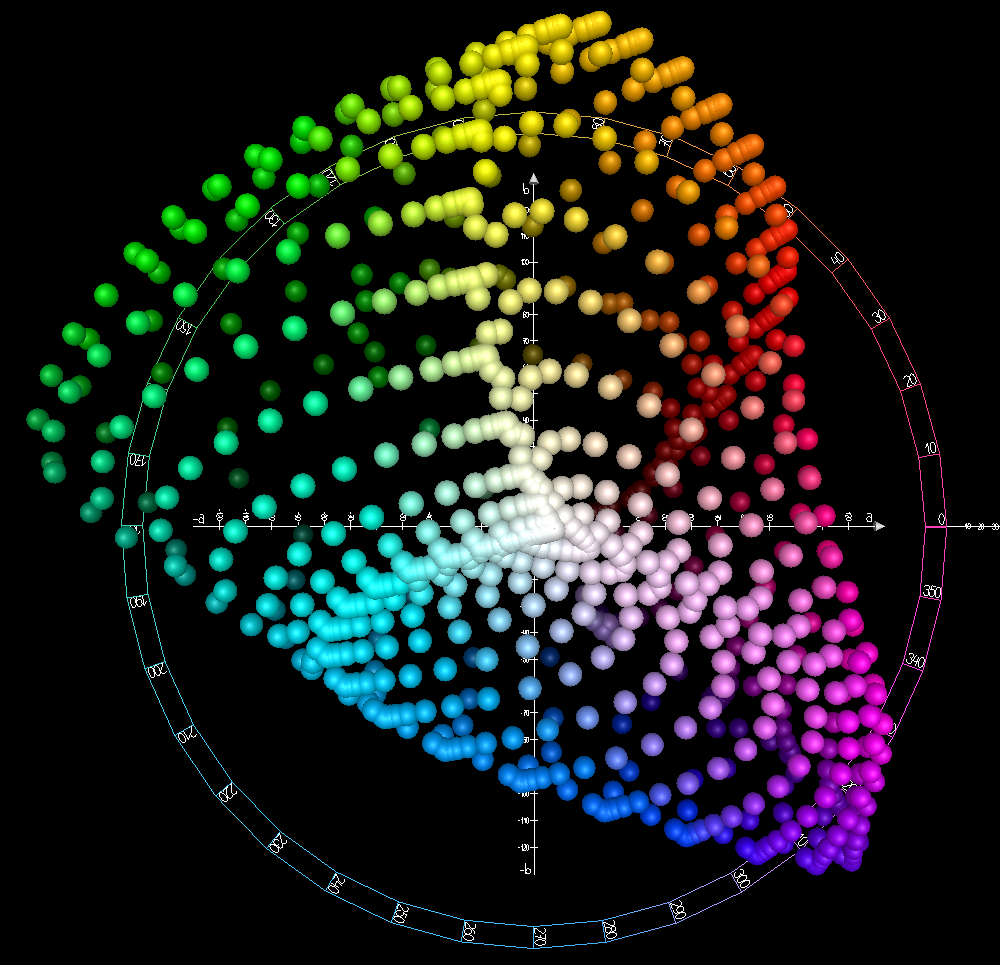The color processor
This tool is inspired on various processing tools such as awk, sed and imagemagick. There is no processing library for single color operations, be it interactively or not.
colp attempts to solve that. It supports a number of color models (specified later in this README). The goal is to have the ability to script and automate any algorithmic color transformation.
pip install colp
$ colp 'a=RGB(1,1,1)' # optionally load a color to memory
┌─┐┌─┐┬ ┬─┐
│ │ ││ │─┘
└─┘┘─┘┆─┘┆ the color processor
> a = a.redder() # single channel increment
> a
RGB(2, 1, 1)
> a = a + 1 # all channels increment
> a
RGB(3, 2, 2)
> lightgoldenrodyellow # X11/HTML constants
RGB(250, 250, 210)
> -a # inversion
RGB(252, 253, 253)
> red.rotate(180) == -red == cyan # rotate hue in HSV space
True
> skyblue ; skyblue.brighter() # brighter in HSV space
RGB(135, 206, 235)
RGB(136, 208, 237)
> a_set_of_colors = [RGB(25,25,112), HSV(186,23,90), plum, orchid, fuchsia, HEX('#800080')]
> sorted(a_set_of_colors)
[RGB(25, 25, 112), HEX('#800080'), RGB(218, 112, 214), RGB(221, 160, 221), HSV(186, 23, 90), HEX('#ff00ff')]
>
> cursor = RGB(0,0,0) # define your own custom functions
> def pop_and_turn(x):
> if x: # equivalent to RGB(0,0,0) == 0
> x = x.redder() * 255
> return x.rotate(30)
>
> for i in range(10):
> cursor = pop_and_turn(cursor)
> print(cursor)
>
RGB(255, 0, 127)
RGB(255, 0, 0)
RGB(255, 127, 0)
RGB(255, 255, 0)
RGB(127, 255, 0)
RGB(0, 255, 0)
RGB(0, 255, 127)
RGB(0, 255, 255)
RGB(0, 127, 255)
RGB(0, 0, 255)
> for c in red.interpolate(blue,10): # interpolate between colors
> print(c)
>
RGB(255, 0, 0)
RGB(226, 0, 28)
RGB(198, 0, 56)
RGB(170, 0, 85)
RGB(141, 0, 113)
RGB(113, 0, 141)
RGB(85, 0, 170)
RGB(56, 0, 198)
RGB(28, 0, 226)
HEX('#0000ff')
$ echo "HEX('#ff0000').rotate(15.).to(RGB)" | colp
RGB(255, 63, 0)
from colp import *
print(RGB(1,2,3).to(HEX))
outputs:
HEX('#010203')
Color
├── RGB
│ ├── HEX
│ └── CMYK
├── YIQ
│ ├── YUV
│ ├── YPbPr
│ ├── YDbDr
│ └── YCbCr
│ └── xvYCC
├── CIE
│ ├── CIELAB
│ ├── CIELCh
│ ├── CIEUVW
│ └── CIEXYZ
└── HSV = HSD = HSB = HSI
└── HSL
usage: colp [-h] [-n] [-v] [-c] [-s] [-l SCRIPT_FILE] [VAR [VAR ...]]
Color Processor
positional arguments:
VAR arbitrary python code execution
optional arguments:
-h, --help show this help message and exit
-n, --no-banner don't show banner on interactive mode
-v, --visualizer visualize current color processed
-c, --css-mode css-compliant output
-s, --scripting-mode colp script output, which can be reinterpreted by colp
-l SCRIPT_FILE, --load-script SCRIPT_FILE
load script from file or stdin
- |
+ |
* |
/ |
// |
~ |
^ |
| |
& |
** |
% |
>> |
<< |
< |
> |
<= |
>= |
== |
is |
not |
- HSV Color Specification
- Color Models vs Color Spaces
- rapidtables.com color converter (including formulas)
- colormath-basics
| ✓ RGB/RGBA/HEX: | ✓ HSV=HSB=HSI=HSD: |
 |
 |
| HSL: | CMY[K]: |
 |
 |
| [CIE]LAB: | YCbCr: |
 |
 |
| YIQ: | YUV: |
 |
 |
There are many other useful colorspaces to convert to and only some are listed in this README.
To cover a new colorspace, just add a class that extends Color or, even better, a Color subclass.
There's also definitely some room for automating CSS-file editing.
Pull requests are welcomed!




